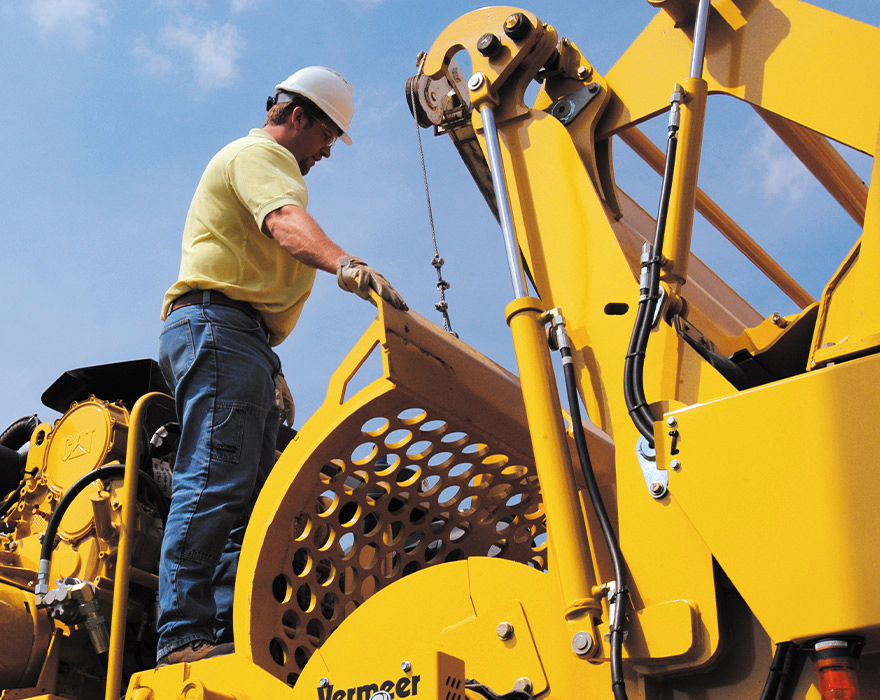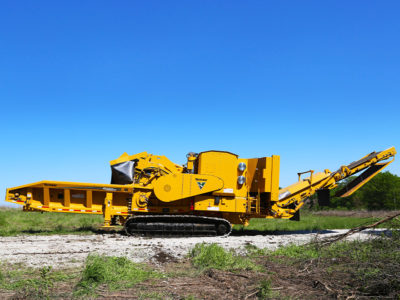The horizontal grinder is the ultimate cleanup machine with the capability to process materials ranging from brush leaves and logs to construction wood and green waste. Jobsite productivity is partially dependent on keeping your Vermeer horizontal grinder in peak performance. Vermeer recycling and forestry sales manager, Ted Dirkx, provided six pro tips to help with horizontal grinder maintenance and help it perform at maximum efficiency.
1. Perform a daily walkaround
As you inspect the machine prior to beginning work on the jobsite each morning, take note of issues such as minor hydraulic leaks that could become larger problems if not addressed. For instance, discoloration or paint peeling on the frame or components around a bearing may indicate an issue. Spotting this early allows you to take corrective action.
2. Clean debris from the grinder and cooling system
Debris quickly accumulates during grinding operations. Periodically power washing or blowing off the machine allows you to spot upcoming problems that may be covered under the debris. Debris not only hides potential issues — it could trap moisture, causing corrosion.
You should check and clean the radiator. Blow any debris away from the air intake screens. Also pay special attention to areas around the engine and hydraulic components where debris may accumulate. Clean around the hydraulic components to allow heat to dissipate.
3. Sort material to minimize contaminants
Horizontal grinder maintenance requires discipline. Contaminants, such as pieces of steel or foreign nonorganic materials, are a leading cause of excessive wear to cutters and screens, so it’s important to remove contaminants onsite.
The heaviest contaminants typically find their way to the bottom of the debris pile. Since an excavator works from the top of the pile, this is often preferable to using a wheel loader with a grapple bucket. An excavator with a bucket and thumb doesn’t pick up as many of those contaminants, and it’s even better with a rotating clamshell bucket that takes a more precise grab.
It’s also important to minimize that amount of dirt you run through the grinder. Dirt, sand and small rocks are abrasive materials that wear the carbide off the cutter tips. Shake all stumps with the loading tool to remove excess dirt prior to running through the grinder.
If you grind a lot of wood waste that contains contaminants like scrap metal, you may be able to minimize unexpected maintenance issues through the use of the Vermeer Damage Defense system. If the mill encounters certain metal contaminants while grinding, the Damage Defense system alerts the grinder control and automatically initiate the shutdown process. The system minimizes the likelihood of metal being pulled into the mill by reversing the feed system immediately, helping prevent significant damage to the grinder.
4. Perform regular preventative horizontal grinder maintenance
A preventive maintenance program that focuses on inspections can alert you to damaged/worn components early. Make sure the preventive maintenance program includes a timeline for inspection of key components, as outlined in the horizontal grinder maintenance manual. Pay attention to greasing schedules for bearings for the cutter mill/hammermill, conveyor and infeed, as well as other components that rotate regularly.
Check fluid levels and filters (fuel, hydraulic and air) regularly. Contamination is the enemy, especially in the hydraulic system. Check all belts for condition and proper tension.

5. Change wear parts as needed
To get optimum production out of your grinder and consistent material sizing, you need to make sure you’re inspecting the wear parts involved with the grinding and cutting process daily. In some cases, these parts need to be inspected even more frequently. Cutter tips, screens, the anvil, wear plates and mill bearings must work together to size organic wood waste material properly. Neglecting any of these wear parts can cause premature wear to other grinder components.
For example, running cutter tips beyond their expected lifespan can inflict damage to the more expensive hammer component. Screens are another wear part that needs frequent attention. As they wear, openings expand. This results in product that’s not sized accurately. Your output will start to get bigger and stringy as you lose vital cutting surfaces. The bars and metal around the screen will be rounded instead of sharp, so you can lose productivity and end-product quality.
A poorly maintained grinder is also less efficient. When cutter tips and screens are not maintained, it takes more horsepower to grind the material.
6. Be selective with the operator
Owners and managers often allow too many operators to run a horizontal grinder. They’re complex machines, so you want an operator familiar enough with the equipment that they can identify when there’s a vibration or it doesn’t sound like it should. If they can stop the machine when it doesn’t sound or feel right, potential problems can be caught early.
If you have a different operator every day of the week, they don’t spend enough time with it consistently. Developing a highly skilled operator who spends a considerable amount of time with a specific machine is something that is commonly overlooked, especially in bigger companies and municipalities where they want employee flexibility. That can lead to bigger issues.
These six pro tips can help increase the efficiency of your horizontal grinder. For more information about horizontal grinder maintenance and performance, contact your local Vermeer dealer.
Always refer to the product’s opeator’s and/or maintenance manual for safety messages and further instructions. Vermeer Corporation reserves the right to make changes in product engineering, design and specifications; add improvements; or discontinue manufacturing or distribution at any time without notice or obligation. Equipment shown is for illustrative purposes only and may display optional accessories or components specific to their global region. Please contact your local Vermeer dealer for more information on machine specifications.
Vermeer and the Vermeer logo are trademarks of Vermeer Manufacturing Company in the U.S. and/or other countries. © 2022 Vermeer Corporation. All Rights Reserved.
